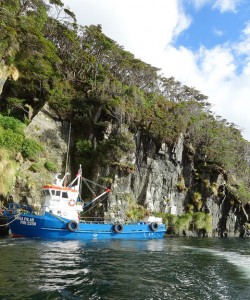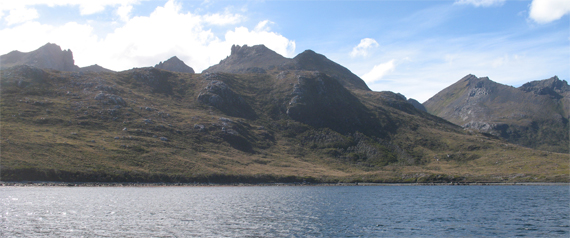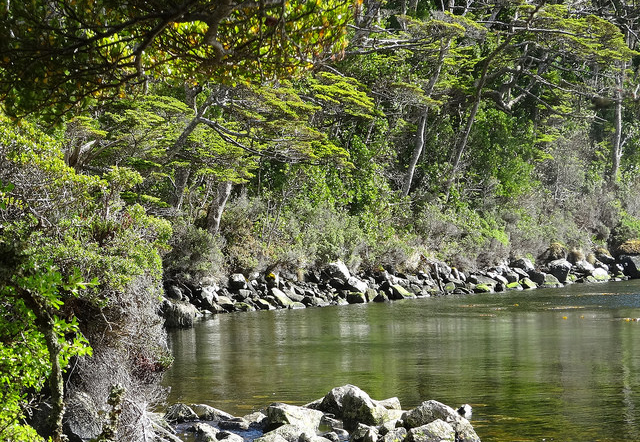From the Field: Bill Buck in Cape Horn 2014, Part 11
Posted in Travelogue on May 1, 2014 by Bill Buck
William R. Buck, Ph.D., is the Mary Flagler Cary Curator of Botany at The New York Botanical Garden. Every January for the last three years, Dr. Buck, a moss specialist, and a team of colleagues have journeyed to the Cape Horn region at the southern tip of South America to document the area’s rich diversity of mosses and search for new species.
January 23, 2014; Bahía Hately, Isla Wollaston, Chile (55°42’S, 67°23’W)

After leaving Fondeadero Hyde yesterday, we headed east to the next bay over, Fondeadero Kendall (55°45’S, 67°23’W). I had collected there some years prior, and so I headed to a different side of the bay with Barb Andreas, following a stream uphill to a series of lakes. We were searching for a submerged moss, Blindia inundata, attached to pebbles in the lake. In short order we found it and headed back to be picked up.
We needed to make our pick-up on time because Barb wanted to be dropped off at a site where I had collected several years ago. Just last year, she published a scientific description of one of my prior moss collections from this spot, naming it Blindia buckii. As she returned to the ship in the Zodiac later on, she gave me two thumbs up, and I knew she had been successful in locating it.
From there, we were told we had to travel four or five hours to reach our night anchorage on the north coast of Isla Wollaston. We arrived in about two and a half hours. As we traveled down the bay, the forests of southern beeches on the slopes of the mountains formed a reticulate pattern of dark green leaves among pale brown trunks. It was then that I noticed that the ship was headed straight for a solid rock cliff. Rock walls towered 50 feet above us on either side.
Thankfully, the water at the base of the cliffs was plenty deep for the ship to tie up alongside the rock wall. In a moment of paranoia, I hoped we would not have an earthquake, which would surely result in boulders pummeling the ship.
I hardly slept last night, and at 3:30 a.m. I decided to visit the deck to see the moon. My intentions were foiled. The overcast sky was pouring rain—no surprise in this climate, but disappointing. The sky had cleared by morning, and with no need to move the ship for the morning’s collecting, we set out for the field.

With the harbor calm, Matt von Konrat and Laura Briscoe remained aboard the ship to photograph the oil-bodies of hepatics, or liverworts. They have documented these fleeting structures in about 80 groups of liverworts during this trip alone. It’s great that we have the facilities for such work because it adds immeasurable value to the collections. When I returned from the field this morning, I handed them a small hepatic in the family Lejeuneaceae, collected less than a half hour earlier, and they immediately photographed its oil-bodies. You can’t get fresher material.
We’re now waiting for the last of our group to return to the ship before we head around the large northern peninsula of Isla Wollaston to a port on the other side. We have only this afternoon and tomorrow to collect, and then we begin the long journey home.

Time has flown by. I have mixed feelings about that. After working in the region for 14 years, this is my last voyage aboard a crabbing ship. I’m trying to imprint the landscape on my memory. On the other hand, I welcome how soon I’ll be going home, never again to endure another too-long flight to the end of the world.
Some of my best field memories are of this region, a place with scarcely any human impact. Each crew of every ship we’ve been on could not have been more helpful, and each ship in turn came to feel like home. I’ve also formed lifelong friendships with some of the expedition participants. I regret that all of this is coming to an end, though the preparation of the manual of Cape Horn mosses and other bryophytes will surely occupy my time for several years to come. Each time I study one of my collections, I’ll remember the time and place that it was made. It’ll bring a smile to my face.
Past Expedition Entries:
Photos provided by Barbara Andreas and Barbara Murray.

